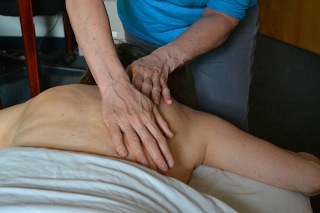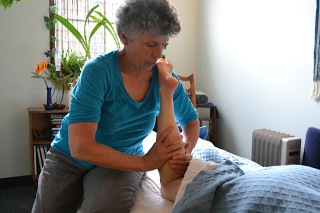MASSAGE – NO LONGER A TOUCHY SUBJECT
There was a time when the word massage conjured images of steamy locker rooms or steamier massage parlors. With the rising popularity of spas and costly pampering that only those with deep pockets and free time could afford, massage assumed a privileged space in which touch performed the task of pleasant soothing.
Today massage therapy is recognized as an effective tool to be used for those suffering from a multitude of physical and emotional problems and by those who seek overall wellness.
Taking this a step further, massage therapy is integral to fitness and athletic performance, preparation, recovery, and injury rehabilitation.
To learn more, I spoke with Sarah Bothfeld, a massage therapist who grew up in Northfield, currently resides in East Montpelier and practices in Montpelier.
Bothfeld offers this definition of massage therapy: “Massage is a gift to the self. It works on the physical, emotional and mental aspects of our being. It can relax, rejuvenate and rehabilitate soft tissue. For the athlete, the person living with chronic pain, the stressed and the recovering, touch with the intent to balance, heal, and support can be a great addition to one’s life.”
Bothfeld lives an active lifestyle and understands the importance of her work. As a child she dared to keep up with her two older brothers as they swam, biked, explored the woods and skied. The outdoors has been important to her family, especially her dad who led the way and continues to bring the family together to sugar each spring.
Bothfeld’s diverse background underpins her ability to relate to her clients. She taught school in Camden, Maine where she acquired a love of sailing, and a boat. When she “needed to get out of town and wanted to do something drastic,” she joined the Peace Corps and spent more than 2 years in Costa Rica where she was able to snorkel, swim, commute by bike and run, “until it was too hot.”
It was in Santa Fe, NM, where Bothfeld transitioned to her profession. Having completed a 1,000 hour program at the New Mexico Academy of Advanced Healing Arts, and with over 500 hours of continuing education during her 25 years experience, she continues today to practice her craft.
On weekdays Bothfeld can be found exercising daily in a gym before her first client arrives. On weekends she is outdoors hiking, paddling and gardening in the summer; skiing Nordic, back country, Alpine or telemark when the snow covers the ground.
Among other things, a massage therapist must be fit for the profession. There seems to be an average of 7 years in the work before a therapist moves on due to the stresses involved.
Is there a licensing procedure for therapists in Vermont? “I think it’s inevitable,” Bothfeld said. “We are one of only a few states where licensing is not required. It will come about as concern for the profession grows.”
Bothfeld is a member of the Amerian Massage Therapy Association, AMTA and a board certified massage therapist. “The AMTA is a professional organization that you join as an active member after graduation from an approved school or with approved credits,” she said. “They provide liability insurance, lobbying and funding toward research and information to the public.” Renewal every four years requires proof of continuing education credits.
A board certified massage therapist has met the standards of the National Certification Board for Therapeutic Massage and Bodywork, NCBTMB, by passing a test and reapplying every two years with appropriate CEUs, indicators of continuing professional excellence.
Exercise and performance involve much more than simply going through the motions, pounding the roads to run, turning the pedals or the paddles, lifting weights, and increasing muscular and cardiovascular strength by whatever means works for you or for your sport.
In Active Vermont you have read of the importance of nutrition, balance, flexibility, recreation and recovery. Today, we add another component, especially useful for those coming off an active summer season and moving into an autumn offseason.
If you do not already include massage as a part of your regular training schedule or wellness program, you might want to consider doing so. Don’t wait until you need it, though massage therapy is an excellent addition to recovery from injury, illness or surgery.
Stress relief through massage is valid, though not the entire picture.
Massage therapy comes in a variety of packages: deep tissue, Swedish (basic techniques that most learn for therapeutic or relaxation), shiatsu, Rolfing®, neuromuscular therapy, medical massage to address needs of oncology, lymph system, scar tissue, orthopedic problems, hypertension, chronic pain and more. As with medicine, the changing landscape of massage mandates specificity for individual needs.
Athletes gravitate towards a form of sports massage that is functionally a composite of techniques.
A therapist massages muscles to reduce pain and fatigue, increase flexibility and circulation, blood flow, and broaden joint range of motion.
An athlete, for example, may complain of knee pain. Frequently the condition is diagnosed, somewhat surprisingly, as not difficulty with the bones in the knee joint, but as a tight illotibial band or IT band syndrome. IT band and even shin splints, are often caused by connective tissue that needs enhanced blood flow that massage stimulates.
Injury, tears, trauma and over use make a muscle group so tight that it can actually pull bones out of alignment and cause further complications, possibly preventable through massage.
While massage therapy used for recovery is a no-brainer, systematic inclusion in a training program helps preventatively by keeping the body nourished with blood which in turn enhances performance, releases toxins, reduces mental and physical stress and brings to the individual an increased self-awareness and knowledge.
How do you choose a massage therapist? Word of mouth or a referral from another trusted professional is one way to find a massage therapist, and perhaps the best way. Remember, however, that what works for one person may not work as well for another and you may want to try several different techniques and therapists.
Interview the therapist before scheduling your first appointment. If you are referred by a medical professional because of an auto accident or workman’s compensation, be sure to check with your insurance company as some treatment is covered.
Frequency of massage depends on individual budget, schedules and needs. Regular massage does, however, encourage consistent and continuing results and benefits.
Massage is a therapy of touch. Touch is physical and has been a practice of healing arts for much of history. In a negative world, touch can be invasive and inappropriate. Used within the context of massage therapy, touch, gentle or powerful, is the means to an end. The technique of touch provides a way to enhance strength and energy, release tension and open the door to quality of life.
10 Tips to Get the Most From Your Massage
American Massage Therapy Association (www.amtamassage.org)
- Be receptive.
- Don’t eat just before your massage.
- Be on time. Take a few minutes to settle, de-stress, before you enter the massage therapy room.
- How much clothing do you need to remove? Speak frankly with your therapist, who will in turn offer you privacy to undress and dress. Most are comfortable removing all clothing. The technique of draping is a part of the practice of massage. Your body will be covered except for the area being massaged. Modesty is always respected.
- This is a big one. You will meet with your therapist before the massage begins to discuss your treatment. You must speak freely of your condition, what you bring to your massage on that particular day. You should let you massage therapist know if you have a problem with the lotion used, the music, or even if you’d prefer to talk or not to talk during your massage. Let your therapist know if you have concerns or anxieties or if something is uncomfortable or insufficient during the massage. He or she wants to make certain that you receive effective work and is dedicated to that purpose.



